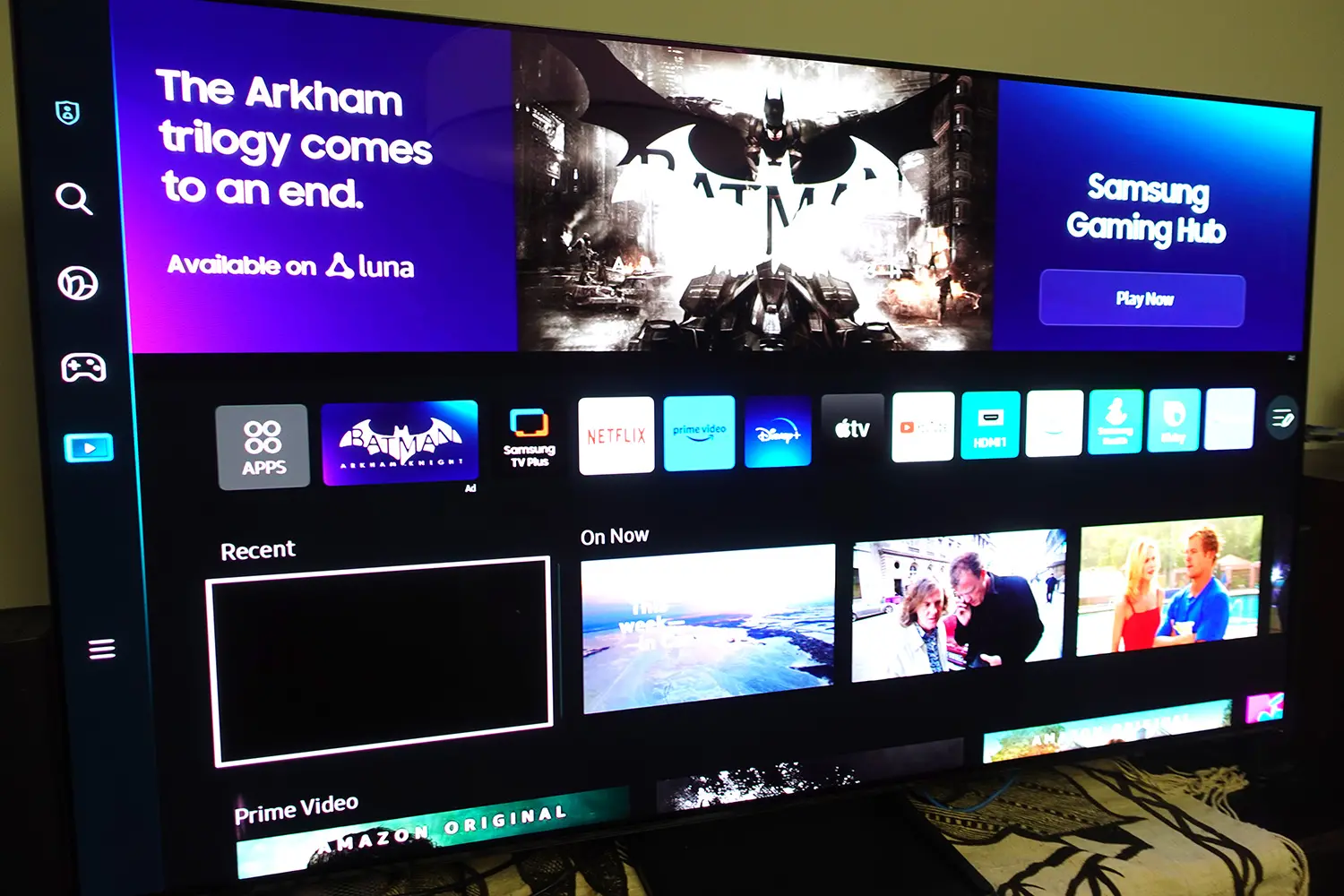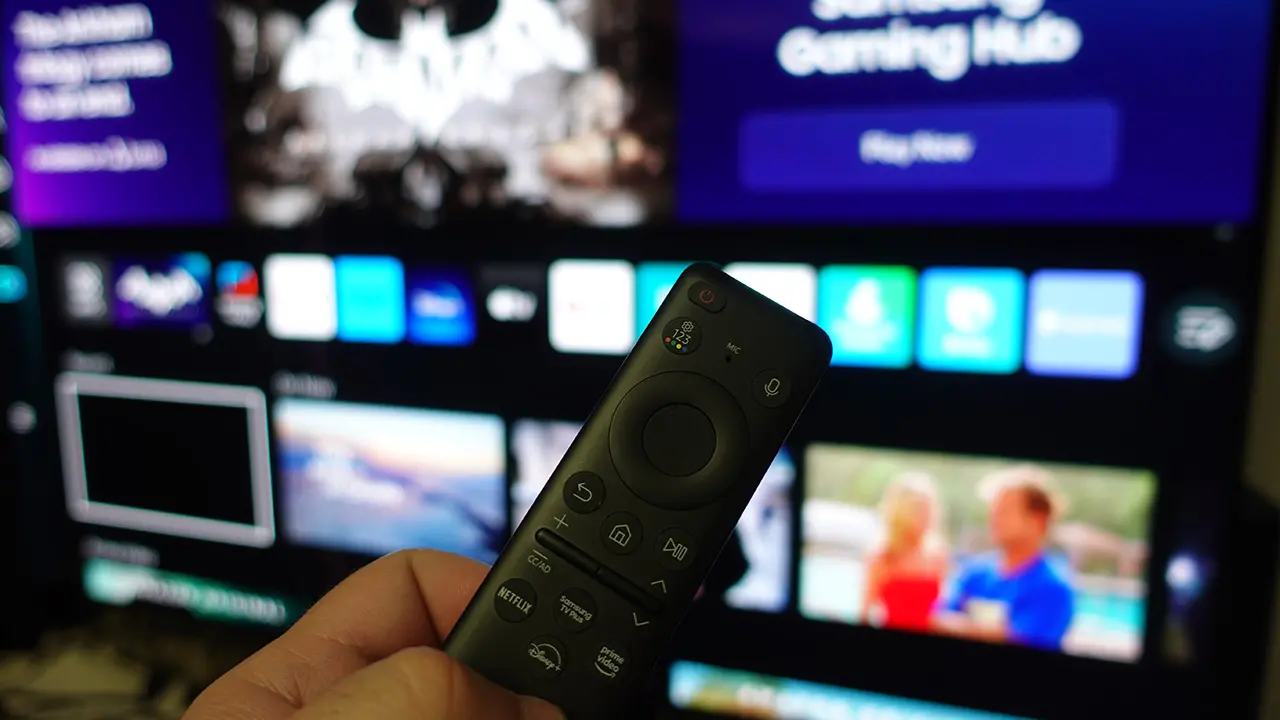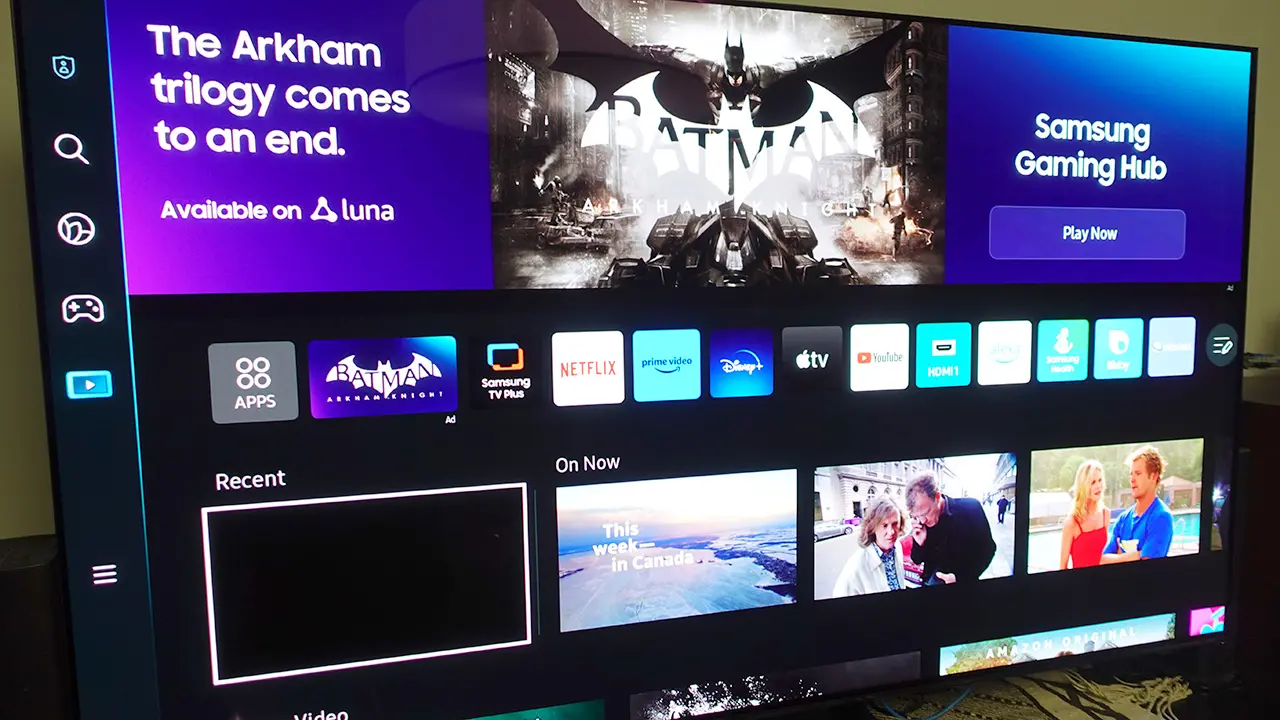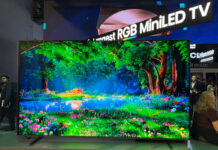
As a long-time OLED owner I was very excited when Samsung finally turned their sights on creating powerful, yet affordable OLED sets for the consumer market. Long reticent to take their extensive OLED manufacturing capabilities and direct them towards larger screen sizes, thanks to developments such as Quantum Dot layering they’re finally committed to producing sets that sit in line with their flagship LED offerings. I had the chance to test the 65″ OLED 4K S92C smart TV. Does the performance of this set live up to the hype? Read on to find out!
Specifications of the Samsung S92C
- Resolution: 3840×2160 pixels
- Refresh rate: 120Hz (Up to 144Hz)
- Neural Quantum Processor 4K
- HDR 10+
- Game features: Auto Game Mode, Freesync Premium
- 4 HDMI inputs, 144Hz max on all
- Ethernet, Wi-Fi, Bluetooth 5.2
Technology behind the Samsung S92C OLED television
For years now there’s been a debate for big-screen TV fans between two competing technologies, LED on one side with its backlight providing impressive images even in bright rooms, and OLED, the more “purist” choice with its pure blacks perfect for a dimly lit theatre. Samsung helped lead the charge on the LED front, stalwartly advocating for the technology against its most bitter Korean rival. Yet throughout this entire period Samsung Displays (the sister company to the main TV division) was churning out millions of OLEDs for smartphones, including those from a certain fruit-named company. At long last the company is committed to release TVs using this technology—but with a twist. By employing the Quantum Dot technology that improved their LED offerings atop an OLED platform, they are merging the best of each platform, resulting in purer colours, higher peak brightness, and what may well be the pinnacle of performance for the television market.
In a very simplistic summary, Quantum Dot works by using proprietary technology to use subpixels to augment underlying blue OLEDs with Red and Green illumination. Since the various OLED colours decay at different rates, this provides a uniformity of the single colour (Blue) which is then transformed when required with various shades of Red and Green, a magic-like trick that allows for over 1000 candles/m brightness at peak, 100% colour gamut, impressive HDR imagery, all with the inherent speed of the self-emissive technology. This is powerful stuff, and the end results are indeed quite impressive. Essentially you’re getting the best of both worlds—the inky blacks of OLED, with its near-instantaneous response time, and high peak brightness levels that provide perfect punch when required, yet never sacrificing accuracy in favour of a blown-out look.

Out of the box with the Samsung S92C OLED television
I sometimes have to stop and remember that my first high definition TV was a 3-gun rear projector that weighed over 100 pounds and stuck out feet from the wall, requiring regular calibration and producing a picture that these days would be considered unacceptable to the point of ridiculousness. The credit-card thinness of OLED is almost old-hat these days, yet when unboxing this set I was reminded just how far we’ve come in these few years.
The styling on the S92C is basic but functional, and I was slightly bemused that the plastic stand elements are held in place without need for screws. There’s a heavy metal base in which the feet slide in, but it all looks a bit precarious, even if when actually testing things it’s certainly secure enough. If the set was permanently placed it would be wall mounted via the VESA holes on the back, of course, but the included stand is satisfactory if slightly clunky, angled backwards in a way that I’m not entirely satisfied with.
The included remote has plenty of buttons, but the tiny black plastic design makes it hard to find in the dark, especially as it lacks any backlighting. Still, the ergonomic design works well, from the raised volume buttons to the circle navigation pad for navigating menus. It’s decent, but hardly a premium offering compared to other models.
Setting up the Samsung S92C OLED television
Testing this TV is one of those rare times when being a Samsung phone user comes in handy indeed. Out of the box the menu system is easy to parse, and a series of guided questions gets things up and running quickly. With both Wi-Fi and Ethernet options the first thing to do is to get all the software up to date. Then, you’ll want to dial in the picture settings for each mode and input. Out of the box the colours are wildly inaccurate, with motion smoothing and other built-in features turned on. While it’s true these are highly powerful features that use advanced computation to smooth out screen judder and the like, for watching films in particular this can result in the dreaded “soap opera effect”—where everything takes on a glassy, plastic look that’s more like a video game than what the filmmakers intended. As is the case with most modern televisions the key to any initial setup is to turn most of this nonsense off if you’re primarily using the set for film or TV show viewing.
Luckily, the Filmmaker Mode implementation does most of this for you, and right from the outset the more accurate colours and removal of things like “eco mode” that interfere with accuracy are eschewed. One can always use colourimeters and other professional modes to fully calibrate, but for Samsung phone users there’s a fantastic option where you can basically use your phone’s camera to calibrate the TV. Put your phone’s camera against the screen and a series of coloured boxes flash along. Afterwards, you have a specifically calibrated set dialed to your own setting. While this of course doesn’t replace the accuracy of a true in-home ISF calibration, it’s a pretty good solution, and one that makes the process positively painless.
Furthermore, if you do want to crank up the motion smoothing and other capabilities you can do so on an input-by-input basis. So, for example, for regular TV viewing you may wish to choose a picture mode with these options turned on, but reserve one of your other HDMI inputs (and most definitely the streaming services) to select either filmmaker or the movie calibrated modes for the most accurate picture possible.

Picture quality on the S92C OLED television
Moving out an older OLED model and replacing it (temporarily) with the S92C in place, it was immediately evident just how much more bright and intense peak elements are with this model. It’s an unfair comparison, perhaps, but in direct contrast to what was a flagship model only a few years ago (with a price tag back then at least five times (!) more than this unit), it’s impressive to see back-to-back how things have improved within the 65” form factor.
Regular viewing is of course great, but the real test is of course HDR to truly showcase the capabilities of the set. Annoyingly Samsung still hasn’t licensed Dolby Vision on their sets, so you’re “limited” to HDR 10 for most titles, or HDR 10+ for the few services that support this augmented version of the base implementation. Dolby Vision has some benefits, particularly for those wanting to adhere as closely to the disc mastering’s intent. However, disc/streamer complies with the regular HDR signal, so for the vast majority of users this will be a non-issue. Still, it’s aggravating that we can’t have it all, and that licensing features like this continue to plague the universal adoption through every product marque and line.
To test the S92C TV I threw on a couple of masterpieces from Denis Villeneuve, finding that the challenging Blade Runner 2049 and Dune encode excellent ways of showcasing fine detail, colour reproduction within a relatively narrow gamut, and the exquisite delineation between darks and light that cinematographer Roger Deakins is roundly celebrated for. Switching between the “calibrated” movie mode thanks to my smartphone and the default filmmaker settings showed a slightly desaturated image from the former, particularly dialing back some of the reds in the desert sands of Arakkis. Again, this is no substitute for a careful full calibration, but it’s a more subtle, granular option right out of the box than I’ve ever had the chance to play with.
Putting in the Oscar winner Everything Everywhere All at Once showed off some more kinetic imagery, and the S92C never balked at any of the scenes. With all motion and clarity settings disabled it was still a highly cinematic presentation, free from most artifacts. I was particularly pleased in all these titles with how smooth the gradations are between colours—a true testament to the processing power of these sets.
Finally, I adore how 4:3 Black and White titles appear on OLED, the pillar-box side bars blending in perfectly in a dark room like you have an Academy-ratio screen hanging on your wall. I tested the S92C using Casablanca, and for a film that was released over eight decades ago it still looks positively stunning. It may take the most modern of sets to truly experience classic films in all their glory, and the Samsung S92C is certainly up for that challenge.
Gaming on the Samsung S92C OLED Television
Full stop—I’m not a gamer, and do not have a modern console to test. However, the specifications indicate that this is a highly capable model complete with Freesync and Motion Xcelerator Turbo Pro 144Hz capabilities on every HDMI input. These features allow for blistering fast performance for PC gamers and maximize the best that the modern consoles have to offer. Given the near instantaneous on/off of OLED pixels, and the lack of “smearing” that LED suffers from with quick motion, this is a prime technology for any serious gamer. And, thanks to the methods that essentially remove any prior concerns of image retention and the like, it truly is the only real choice for those that are wanting the best from the latest of gaming platforms.
Smart TV features on the Samsung S92C OLED TV
Of course, for many these days discs and gaming is secondary to streaming services, and the main software pages have links to all the major players. The speed of navigation is more than satisfactory, and there’s little need for an external box to stream from Netflix, Disney+, Prime and the like, given the built-in HDR capabilities and ease of use. There’s also voice assistance support from Amazon’s Alexa and Samsung’s own Bixby, allowing you to talk to your TV and have it perform many of the key functions without ever touching the remote. We’ve come to expect such features on a modern set, and the S92C does not disappoint.
Sound on the Samsung S92C television
The sound from the built-in speakers is…fine. It’s certainly good enough for setting things up, but on a set like this you really should consider investing in a sound bar or even a full home theatre system to match the power of the picture with the most robust of soundscape that your setup can accommodate. Out of the box it’s clear, with a bit of punch, but it’s nowhere near as capable as many economical of external sound solutions, let alone robust home theatre sound setups. There are features such as Bluetooth that are welcome, and thanks to eARC technology you can simplify the cabling to make setup to external devices a breeze. There are some surround sound capabilities from the built-in system, from top-channel drivers that are compatible with Dolby Atmos for some spatial audio fun, and a feature dubbed “object tracking sound lite”. The latter uses the various speakers to give a sense of aural movement. It’s satisfactory for when you’re locked into using TV sound, but like with any other set the S92C benefits when matching an appropriate sound solution to the exceptional picture presentation from this remarkable TV.
Final thoughts on the Samsung S92C OLED TV
Is it OK to be annoyed I’ve got to send this one back? Suffice it to say, I’m extremely pleased with how Samsung has firmly embraced OLED technology, and with their QD implementation, they show a bold way forward to keep this self-emissive mode of presentation relevant for consumer sets for years to come. Some of the limitations are frustrating, such as a lack of Dolby Vision support, but thanks to enormously capable processing, a class-leading screen, a simple yet capable form factor and speedy navigation through its menu system, plus the smartphone calibration trick, this is definitely a set that should be on your radar. We’re at a magic time where these razor-thin devices produce imagery that rival that of the finest cinemas, and the Samsung S92C OLED lands firmly in that pack of the best television sets you can buy right now.
You can find the Samsung OLED 4K S92C smart TV at Best Buy.





What exactly are the differences between qn65s92 and qn65s90
Outstanding review. Answered all he questions a serious (65-year old female) tv and movie afficiato could want or need. Is the 77” as good, better or not as good please. Thanks so much❣️ PS: about to order a Switch and take up gaming with my 6-year old grandson lol. Will never become as fast as this tv is capable of, but appreciate the challenge HAHA.
Hi, the 77″ inch TV has the same features and display quality as the 65 inch TV. The experience would be similar on both except for the larger screen size on the 77″.
Comments are closed.